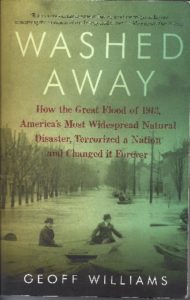Pete’s Pick
June 2016
Washed Away: How the Great Flood of 1913, America’s Most Widespread Natural Disaster, Terrorized a Nation, and Changed it Forever
Geoff Williams, Published 2013
Introduction
This book is an extraordinarily researched story of a national disaster not well known in the country’s history. It recounts the story of this disaster from the setting of many different communities in 14 states and dozens of people whose lives are changed as a result.
Author
Geoff Williams is also the author of C.C. Pyle’s Amazing Foot Race: The True Story of the 1928 Coast-to-Coast Run Across America and is a journalist for several news wires including Reuters and random publications such as Huffington Post and CNNMoney.com.
Story
This book tells the story of the most widespread natural disaster the country has experienced in which more than 1500 people lost their lives across 14 states. However, it is a little-known national disaster as it tended to be referred to locally, i.e. the Great Dayton Flood of 1913.
Over the span of some 300 pages, Williams reports a well-researched story of tragedy and heroism during the last week of March 1913. Starting with the outbreak of tornadoes in Omaha, NE on Easter Sunday, March 23, followed by torrential rains which inundated Ohio, Indiana, Pennsylvania and caused major flooding of every river east of the Mississippi by the end of that week, Williams tells the incredible stories of heroism and tragedy. It is a heart-thumping page turner as we are carried back and forth between Omaha, NE; Dayton, OH; Fort Wayne, OH; Indianapolis, IN; Columbus, OH; Peru, IN; New Castle, PA and many other communities over the course of six days. We follow the heroic efforts of numerous individuals we come to know. We follow Sam Bundy who worked nonstop for 57 hours rescuing well over 100 individuals. John Bell spliced together and maintained the only telephone link between Dayton, OH and the outside world. Thomas Green was Ohio Governor James Cox’s telephone operator and kept him in contact with communities and governmental agencies. We meet John Patterson, founder of National Cash Register Company, who provided his corporate facility as a refuge center and provider of supplies and equipment including 167 row boats built in his shops and used in rescue operations in Dayton, OH. Geoff Williams takes us through these six days hour by hour going from one location to another and back again as the story unwinds. We become caught up in the stress and anxiety, horror and joy of each person’s experience. We are saddened by so many deaths and rejoice at the countless rescues that are recounted during each hour of each day.
The story Williams recounts is also the story of how the absence of any national program for disaster relief or for flood control, and how the absence of the kind of communications capabilities we so take for granted today impacted millions of people from Nebraska to Vermont during this last week of March 1913. As a result of these experiences, a national flood control system was developed which in the 100 years since the disaster has proven its worth many times. Finally, in the Epilogue we are able to see how the story ends for many of these folks we have gotten to know. It is a story of challenge, of resourcefulness, of innovation, of incredible luck, and of heroism that leaves us gasping in anticipation and clapping with exuberance as story after story takes place.
Evaluation
This is a well-documented account of a little known yet significant national disaster which gave rise to much of the flood control measures that are in use in the country today. It recounts in exquisite fashion the stories of dozens of people who died or were rescued or did the rescuing during an intense weather phenomenon not matched again until Hurricane Katrina and more recently Hurricane Sandy.
I highly recommend it.
